First sexual experience
... or a professional DSLR camera in the hands of a beginner.

On the example of me and the new Pentax K-7 . Extremely many text based on real events;) Traffic !
Before you start writing a gigabyte of boring text, I would like to make a small preface.
')
My father began to take a great interest in photography from about his school years - in the army, his skill was in great demand. In exchange for a memorable photo colleagues were willing to go to much. A beautiful army album, Volga and Muscovites at a wedding, small Bumburum in a crib - it is so pleasant to be nostalgic, looking at the irretrievably gone!
Rewinding a couple of decades ahead, holding the next digital creation, it’s hard to imagine that the film was scarce at one time, and for the black and white shots you had to conjure with solutions while sitting in a dark bathroom.
Fortunately (or unfortunately?), This inheritance was inherited to me in the minimum size - I love to take pictures of course, but I am not a fan of it. Well, or to be more precise - the majority of those pictures that I do do not bring me any pleasure at all - I don’t even want to print them for memory.
Nevertheless, the realization that time is still irretrievably going away is present - quite recently I thought that I would have time to pofot my son, who was wrapped in diapers, and he was out, almost running around) Constantly postponing “damn, but I still have time, Well, not going anywhere! ”- in general, part of his future memories dad already missed - minus in karma)
There is a second point. " Yes, he is just to reach her!" ”- whispered evil tongues, responding about my passion for technology) Well, I don’t agree about the“ darts ”, but I’m really interested in a lot of pieces of iron. It’s one thing to see a beautiful advertisement on TV, and another to figure it all out on your own, getting the most experience and knowledge (it’s not always easy, but I’m not shy about sharing the experience with others). Familiarity with the widest possible range of glands allows you to become diversified, and to get more and more reviews in objectivity, because everything is relative! Nevertheless, I am always looking for ways to improve them. And if the texts depend only on me, then the same photos - from the phase of the moon and, in fact, the camera. The remaining 99% - from the photographer;)
The moment came when the pillow-shaped frames of straight flat surfaces taken near (as well as vain attempts to correct them with a perspective crop in Photoshop) were finally fed up. Like Estonian autofocus attempts to my Canon A650IS to catch the desired area of a laptop, which you want to focus on. Like sluggishness after pulling the trigger, one sharp frame of five. Like ... yes a lot, in fact, what does not suit!
And I still decided. Knowing how to swim from a force of 100 meters like a dog, jump into the water without a life buoy. On my shoulder is a black bag with a chrome Pentax inscription. Inside it is a brand new Pentax K-7 , with just the green lens of which makes it look around for something like that. Looking ahead - I did not buy it, so do not be jealous and read calmly)
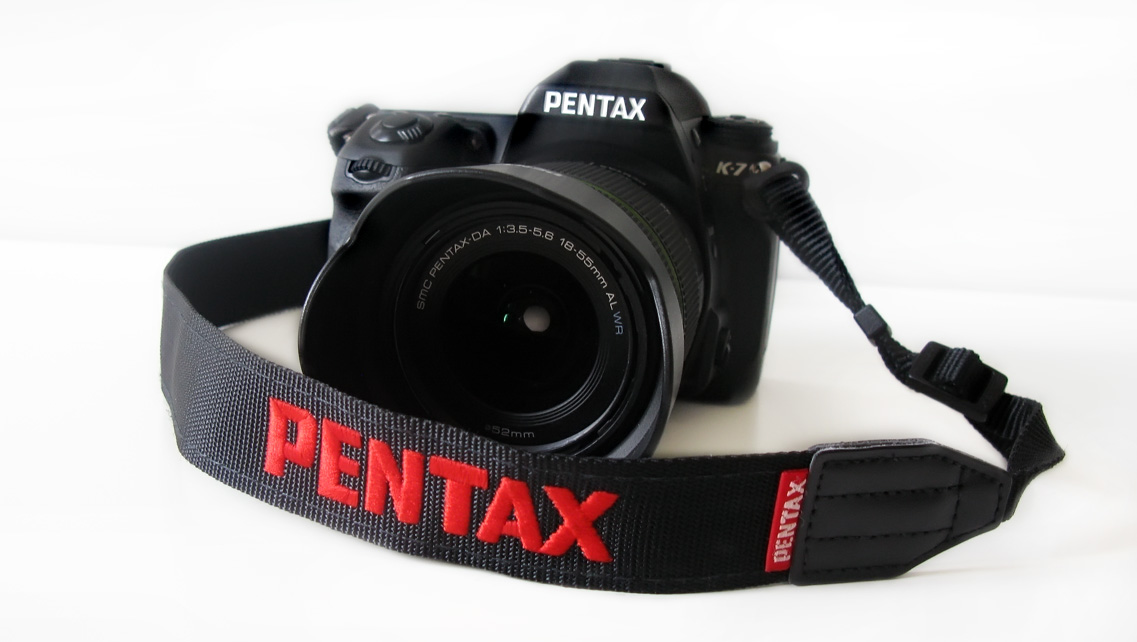
Everything written further is a purely personal opinion and own winding on the mustache with elements of the review. There will be almost no comparison with anything, as such, with my soap box, stupid, and I touched the other cameras only superficially. I will also try to avoid highly intelligent photo-terms, the meaning of which is often to be found in Wikipedia. So do not judge strictly - I will definitely make it up. Ken Rockwell, are you buckled up? )) Then what are we waiting for - let's go!
Camera Pentax K-7 came to the market only this year, to replace its predecessor K20D , which has long been the flagship in the K-series. Thank God, there was no megapixel race, however, now the title of leader belongs to the novice by right - it fixes a lot of flaws, improved some points and performance characteristics in general. In order not to be unfounded, here are the main parameters of the new camera, and this link is a comparison with the K20D.
It so happened that the “first night” the camera spent with someone else) I didn’t get it far from being fully loaded (only the carcass itself, the whale lens, battery, charging, manual and bag), however, the full list “ details "consists of as many as 15 points:

With a rather modest size of 130x96x72 (in mm), the baby donut weighs only 670 grams without a battery, and with it (lithium-ion at 1860 mAh), all 750 grams. Despite the modest weight, there are strong metal chassis inside, and the case itself is molded from a light magnesium alloy, which will only have a positive effect in the long run. In the case there is a huge amount (if you believe the manufacturer, then as much as 77) gaskets that protect the stuffing from moisture, dust and other misfortunes. In addition, to protect the matrix, a set of solutions is also used, about which a little later.

In my case, a Pentax DA 18-55mm f / 3.5-5.6 AL WR all-weather whale lens (WR = Water Resistant) was attached to the camera, the weight of the camera with which is a little less than one kilo.

Optics, although it has dust- and moisture-proof properties, I did not dare to sink to the bottom of a bathtub or aquarium. But in rainy weather you can take a picture of a beautiful lady under an umbrella without any fear for the safety of equipment. By the way, it’s clear here that other manufacturers have lenses with such properties that make good money.

The rough rubberized surface in the place of the grip allows the camera to be held securely in your hand. The ergonomics are really well thought out - special reliefs for the thumb and index finger of the right hand are very convenient, the shutter button is located at the optimum angle. The camera offers its owner a lot of settings controls placed on the case, which are almost from all sides. Let us dwell on this in more detail.
Top view . To the right of the flash cover there is a sufficiently large display, in front of which there is a “trigger” and two buttons (exposure compensation and photosensitivity control).


The shutter button, which you have to press, you have to admit, is a real pleasure, it has a small lever around it - it turns the camera on and off, and also acts as an aperture repeater in an unlatched position.
On the left side of the flash, there is an exposure selector dial, under which the metering type switch is coaxially located (centered, center-weighted, and multi-segment).
Bottom view . It's good that at least there are no buttons) From the available - a hole for a tripod, a metal door of the battery compartment (you just can’t open it!) And a rubber stopper that allows you to pick up an additional battery pack.

Right view . Behind the plastic cover is a slot for an SD card, and under a separate, but rubber, cap is a connector for connecting the remote control.

Left view . Bottom is the switch of the basic focusing mode (autofocus single shots, continuous autofocus and manual focus).


Above - a button to enable recording of images in the RAW-format (more precisely, how to set up in the menu - RAW, RAW + JPEG or only JPEG), activation of the built-in flash and X-Sync plug for external. There are also two rubberized latches on the handle itself - behind one hides a jack for an external stereo microphone, under the second one there is a power jack, HDMI and a PC / AV output for connecting to a TV.
Front view If you look at the camera from the front, then on the handle you can see a small “window” - a receiver for remote control. Slightly higher - a gear control wheel for changing parameters (for example, the same ISO - holding the button with the index finger, and turning the wheel with the middle one by changing the values) selected on the screen. Next - "eye" autofocus. The lens has a button that allows you to remove it.


Thanks to the KAF2 bayonet, the camera has no compatibility problems with any of the lenses (KAF / KAF / KAF2 / KAF3) ever produced by Pentax.
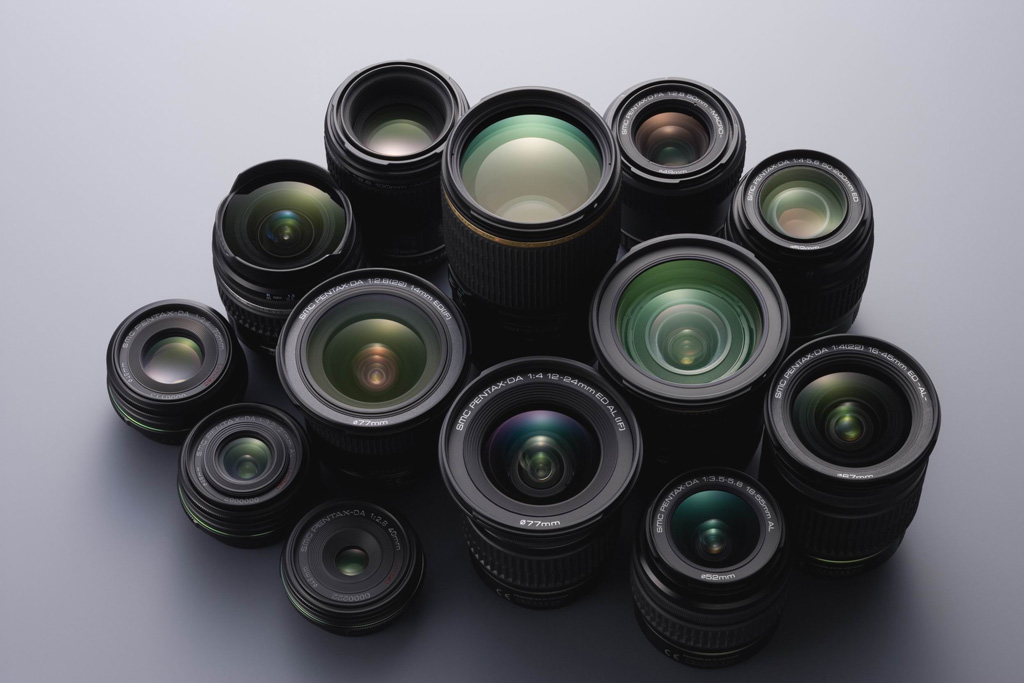
Rear view . Here it is really the thickest) The lion's share of the surface is occupied by a color LCD screen with a diagonal of 3 inches (921,000 pixels, the viewing angle is 170 degrees from all sides), from which side there are literally scatterings of buttons.
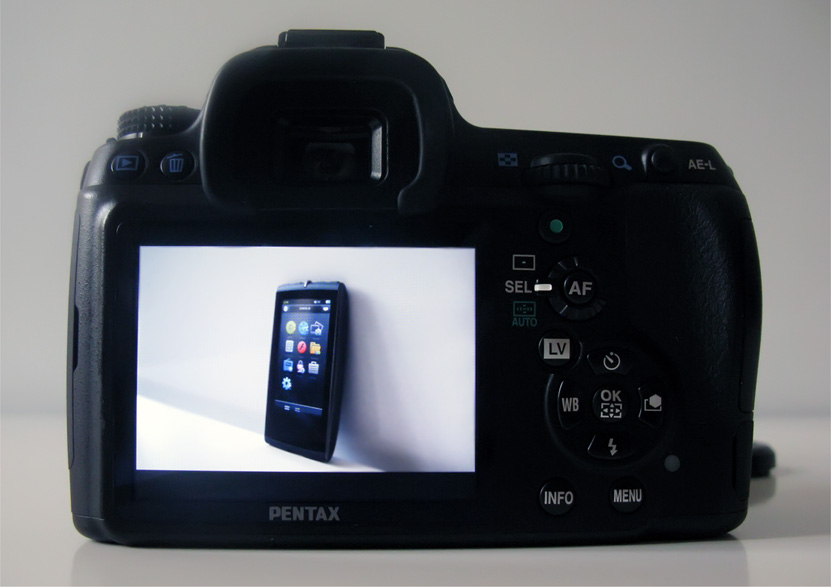
At the top left (under the selector dial), there are standard buttons for viewing and deleting images. To the right is the telescopic sight (he is the viewfinder, this time possessing a 100% frame coverage), the second control wheel (the first was under the trigger) and the fade button of the exposure. Below is a three-position switch for selecting autofocus (in the center, at the selected point and multizone), and already on the switch itself is the green focus control button in LiveView mode. This is the mode when the disgrace that occurs in front of the lens is displayed on the screen (as in compacts) - it is turned on with the LV button, which is slightly lower.
The familiar element is a circle of five buttons (aka navipad), thanks to which most of the actions on the screen are done. In addition to navigation, the buttons cause settings for the time delay when shooting, flash, white balance and picture style - everything later.

The remaining two buttons (Info and Menu) display information about the settings and the main menu, respectively.
So, well, everything seems to be)
The heart of the device (except for the matrix) is the new PRIME II processor (aka PENTAX Real Image Engine II). Pentax engineers took part in the development of the matrix from Samsung. Due to the fact that information from the matrix is read in four channels at once (and not two, as it was earlier), it was possible to increase the speed of the camera to 5 frames per second (with a buffer of 15 RAW or 40 JPEG), as well as completely reveal its other important potential - shooting video.
The second new processor (well, or improved, okay), autofocus, is called SAFOX VIII + and allows you to process 11 focus areas much faster than the old one. The highlight of this processor is the ability of the camera itself to evaluate the prevailing wavelengths in ambient light and, depending on this, “tighten the necessary nuts” in the autofocus system (which would be almost impossible to do manually). In some cases, it will only be necessary to set the necessary correction in the settings (front- and back-focus correction) in the autofocus system, since the camera allows it. A nice bonus would be the ability to save settings for 20 different lenses (does anyone even have such a park?).
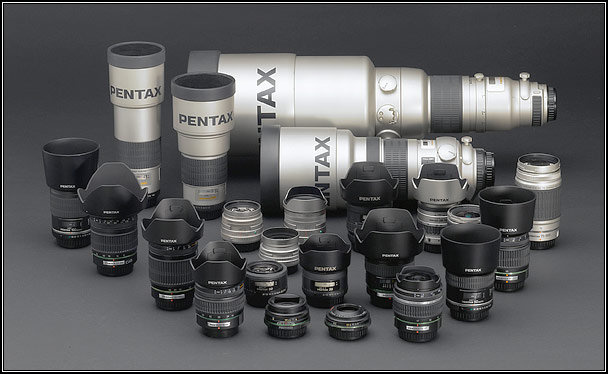
The metering system has also matured - from 16-segment (with K20D) to 77!
The camera uses electromechanical optical stabilization (Shake Reduction) due to the shift of the matrix along the X and Y axes in the electromagnetic field. Since this does not introduce additional distortion in the image, then stabilization will work in any lenses.
The selector on the left has the following modes:
P (Perfect) - program mode with a choice of program line;
Sv is the priority of sensitivity;
Av (Awesome Priority) - aperture priority;
Tv (Totally Awesome Priority) - priority exposure;
TAv - shutter speed + aperture priority;
M (Make pizdato Magic) - manual mode;
B (Best) - long exposure mode when the shutter is open while the shutter button is held down;
X (eXclusive) - flash sync speed;
USER - saved user settings;
Video - recording a home video) In this mode, the display always turns on;
Green - fully automatic installation, for people like me)
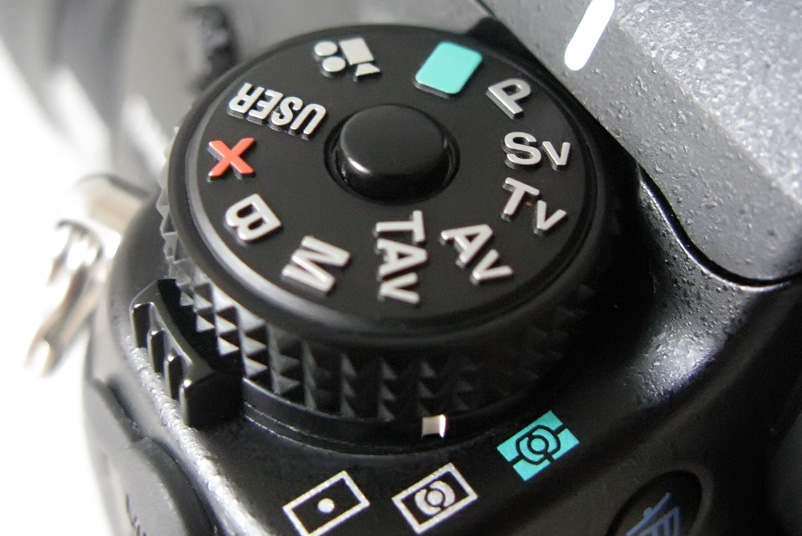
The program line is the choice by the camera of the optimal exposure parameter (opening the aperture and shortening the shutter speed) under different light conditions. The camera is available 6 software lines.
To turn the selector, you need to first press a small button on it - in principle, this is correct (you cannot accidentally knock down the settings), on the other hand, it is not very convenient in practice. And people with thumbs can feel additional discomfort.
The camera turns on almost instantly and immediately allows you to take a picture. The revised shutter is designed for 100K “shots without misfire” and is able to work with shutter speeds from 1/8000 to 30 seconds (not counting the Bulb mode). For all the time that I used the device (about 2 weeks), I did not manage to discharge the battery. The manufacturer says that it should be enough for an average of 1000 “shots” or 440 minutes of video - I believe) The autofocus light is green, although in the same K20D, the built-in flash was used for this purpose.
About the video. Someone will say that shooting a video on a camera is equivalent to driving a nail with a microscope and will be partly right. At least, I also consider that a specialized device should perform a specific function - the phone should ring, the player should listen to music, the camera should be photographed, and the video camera should shoot.
Nevertheless, the recording function is implemented well and much better than the competitors in its class. The camera allows recording Motion JPEG (AVI) with a maximum resolution of up to 1536x1024 @ 30fps (3: 2) or in HD (1280x720, 16: 9) with the same 30 frames. What is nice - there is no five minute recording time limit. Therefore, you can shoot very much and you should not be shy. Here you have, for example, rabbits , dachshunds , water lilies , butterflies and just all sorts of beauty .
For me, the possibility of shooting a video was a huge plus - it is sometimes necessary to make a short video for review, but at least you don’t want to carry a separate device for this.
Photos, in addition to JPEG, can also be recorded in RAW (in the name of DNG or the company's PEF format). The new APS-C CMOS-matrix (with Dust Removal II dust removal mechanism) with an effective resolution of 14.6 megapixels and physical dimensions of 23.4 x 15.6 mm allows you to take pictures with a maximum resolution of 4672x3104. The sensitivity range can be adjusted from 100 to 3200 ISO (+ ISO Boost to 6400 in the settings).
By default, the screen displays all the information about all current settings (by the way, the text is easy to read, and the icons are nothing like that), partially duplicated on the display from the top (the green light of which lights up when any button is pressed).
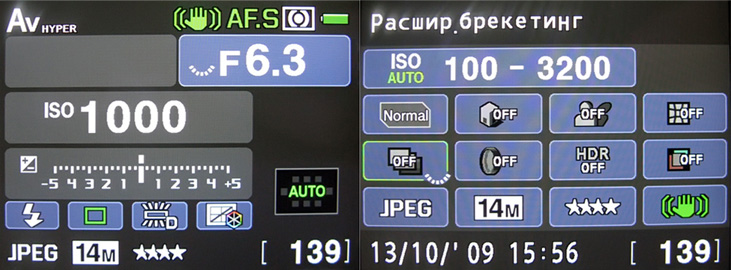
No, it is not at all superfluous - for example, it will help out in the case when the battery sits down or when LiveView (LV) mode is activated.


If in the lens itself we see what will be in the photo, but we don’t see how it will actually be (for example, due to white balance), then everything is immediately visible on the screen in the LV mode. The mode is good for everyone, but it is a little frustrating that it displays reality with a slight delay, especially in low light.
Also, the photographer can always find out information about the settings if he looks into the viewfinder — just below the informative pattern of the new focusing screen, the main settings are visible.
No, that you, they are not! )
Despite the fact that the camera is positioned as a professional by the manufacturer, it is not prohibited to use for beginners and amateurs. Nevertheless, the “greens” can repel the number of various settings offered by the camera - it can easily compete with the professional solutions of other companies. First, the abundance of various options really scares ... but when you get used to navigation and understand what's what, you begin to enjoy the opportunity to customize everything.
The main settings menu contains 4 tabs, each with several pages. I see no reason to list everything - it's easier to look at a picture or specs once:

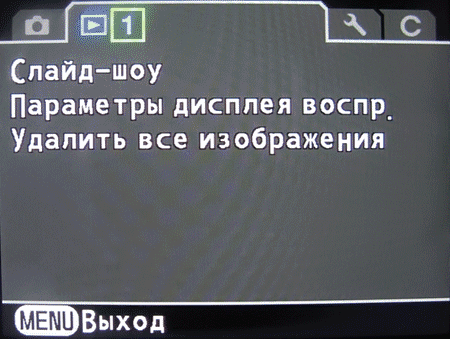
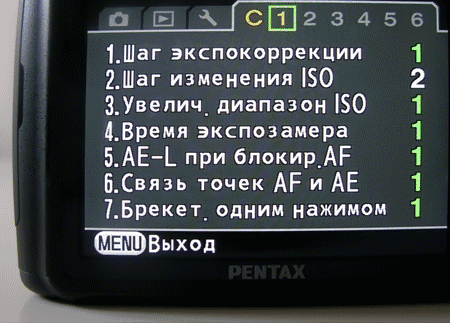
In almost all the modes, you can separately configure the functions of the wheels of choice on the body. About the fact that you can change the white balance, exposure compensation, program line and other sensitivities, I think, there is no point in telling - naturally, all these settings exist in a camera of this level. And I want something about the raisins)
Speaking of white balance, one can not fail to mention the possibility of fine-tuning any of the available presets (there are quite a few) - the adjustment is carried out along two coordinate axes of the color space (BA and GM), the result of moving the point along which you can clearly see on the screen.
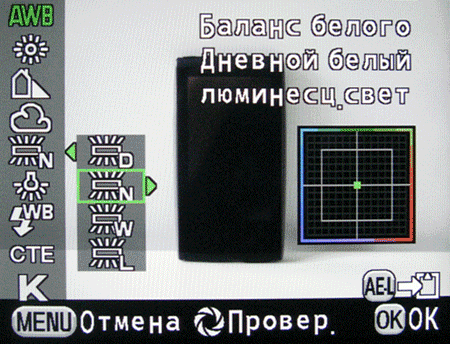
But detailed settings can be made not only for shooting. For example, I was very pleased with the ability to adjust the screen settings (by pressing the right Navi button) for a more accurate light-perception of the footage. Seven styles are available - bright, natural, portrait, landscape, art, faded and monochrome. For each of the style with a step of ± 5 (on a conventional scale), you can edit from five to seven parameters - saturation, color tone, high / low key, overall contrast, contrast in shadows, contrast in highlights and sharpness. And all the parameters will be visually displayed on the right in the vector diagram of the color space.

More beautiful animated film from another review :)

In addition to the styles that do not affect the shooting itself (they are not plot programs!), Filters are also available in the camera - symbolically, but there are seven of them too. They allow you to more significantly change the picture and may be needed, except that, in the case when the finished picture is needed “from the camera”. For everything else, an external editor, the same photoshop, will be much more practical.
By the way, since I started talking about editing. Recently, the letters have become fashionable HDR - someone naively burns pictures in Photoshop, someone connects a few frames manually. In K-7, the work with the extended dynamic range is supported at the hardware level - making three frames with different exposures, the camera at the output gives one already glued picture.
I liked the function of the electronic level (useful for beginners) - when it is activated, the scale of the e-shift in the viewfinder (well, or on the screen) turns into a camera tilt indicator.So, it will be possible to unlearn the obstruction of the horizon quickly enough;) And if the level does not help, then the camera itself will help to fix the jambs, which at minor angles allows the horizon to be automatically corrected.
Someone may be useful interval shooting, allowing you to take up to 99 shots (in 1 second increments and intervals up to one day!). You can also take a picture with a delay of up to one day (the step is also a minute). If desired, you can enter yourself in the EXIF-information of all camera shots by entering the necessary data in the settings via the on-screen keyboard.
In general ... the settings are really car! I think, and even almost certain that even the most confused photographer will like it.
About your own impressions. I really liked the ergonomics of the device - in addition to the dimensions of the case, the layout of the buttons (I was right handed) turned out to be convenient - despite the fact that everything was different on my soap box, I got used to the new control almost immediately.
Sometimes, just taking a few pictures, you can get a result with some small detail, which will not be in ten other frames. Glance, smile, moving object - anything. So the rate of fire here is very helpful. Not excessive in this matter will be the possibility of comparing two frames - each occupies half of the screen and you can clearly see all the differences with a zoom.

Becausethe whale lens is focused by the motor inside the camera; there is a small loss in time. But even in this situation, the focus was induced very quickly and often exactly where I needed) I think, with more sophisticated optics, sharpness is induced almost instantly.
Someone, my words will cause laughter, but still started with something;) Therefore, most of the time I photographed on the automatic settings. And despite this, I still got frames that I would never have done on a soap box. I liked the natural color of the skin, which is obtained as a result. Minimally noisy (apparently, the noise reduction mechanism knows its business) and almost always clear frames - even with a primitive processing in Photoshop (levels, white balance) of a regular jeep (not to mention RAW), photos worthy of a digital frame or photo album are obtained. Due to the fact that there was no software disc with the camera (I didn’t figure out anything to download from the Internet), I edited the DNG files in Photoshop - the flight is normal.
At the maximum resolution, frames (in JPG format) are 6-10MB each, respectively, a 32GB card can be scored only for a couple of battery charges. I used an SD card for 4GB and managed to face the lack of space.
A few words about the documentation that was provided with the camera. Perhaps this is the most detailed manual that I have ever seen! In a small book (300+ pages in size) there was everything - from a camera device, a glossary of accessories, a list of accessories and theory to a description of all the features and nuances of the device itself. Five!

Perhaps it's time to share a couple of shots. Clicking on the thumbnail opens a photo with 30% of the original size.

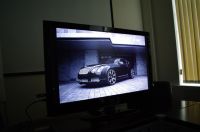









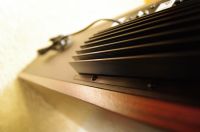
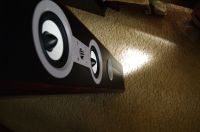







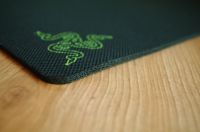

Full-size images (for evaluating noise in different lighting conditions, sharpness, details, color rendering, etc.) can be viewed in this archive (200mb, 25 photos).
I think, not for free travel for the sake of, but mostly advertising for ... a big campaign was arranged for Pentax K-7 - a group of famous photographers was sent to Malaysia so that they could chase the device in every possible way. Accordingly, a separate site was made for this whole business, more precisely, LJ . I strongly recommend to get acquainted - in addition to the smartest photos (including underwater) there is testing of various tools.

But, by the way, more detailed and professional reviews of this camera - one (as much as possible) and two . And here most detailed, but in English.
Liked :
- The device is relatively light and very comfortable in the hand;
- A healthy color screen + all the means to fine-tune it;
- A huge number of various settings + easy navigation in the menu;
- A large number of functional elements, switches and buttons;
- Image processing functions directly on the camera - filters, styles; HDR-shooting function;
- LiveView mode and the ability to shoot high-quality (HD @ 30fps) home video)
- Operating time from one battery charge;
- The speed and accuracy of autofocus;
- The quality of photos, which is not surprising;
- Detailed manual.
Did not like :
Objectively judge the pros and cons of the device relative to competitors in its class, without my own experience of shooting on different cameras, I just can’t) Accordingly, it’s hard to find something that I frankly didn’t like - everything in my camera doesn’t what a comparison with what this camera offers. Therefore, if you close your eyes to the necessary re-habituation to a new type of device, then I simply have nothing to complain about - everything will come and be realized with experience.
On the other hand, if you dig a little, you can still find something. While I didn’t really like the need to press a button on the selector of exposure modes to select the right one, some slowing down the picture on the screen when working in LiveView mode (as well as the inability to rotate the screen itself), and also not the best focus in poor visibility conditions objects). Well, the price (from 45 thousand) for only one carcass ... during the crisis, for many may be high. Although the new flagships never cost a little.
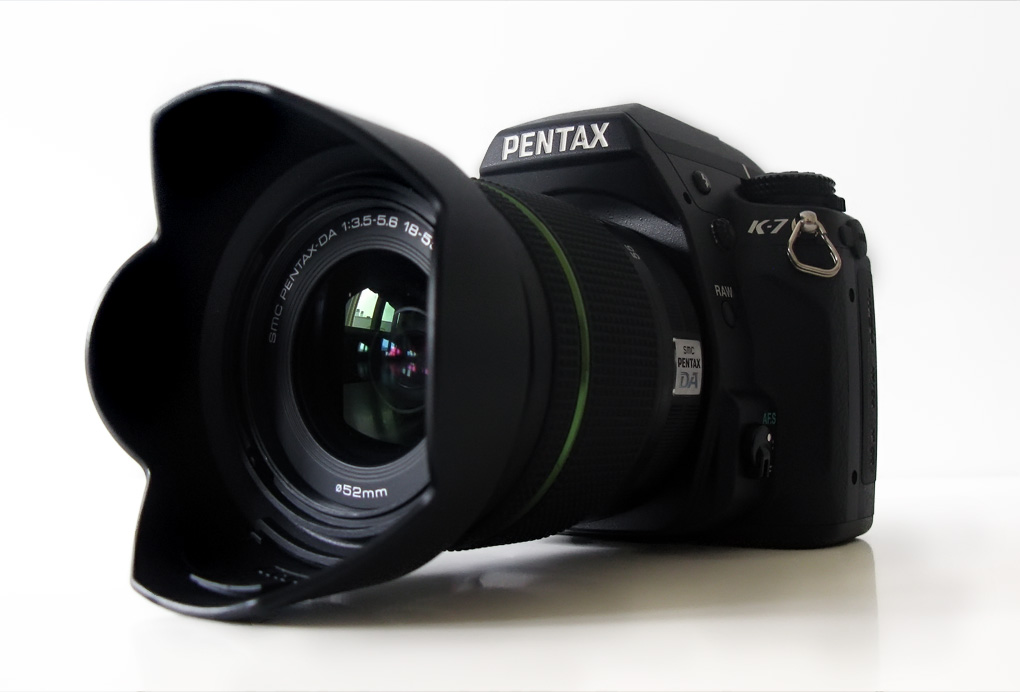
I admit honestly - initially I didn’t even plan to write this review) because I didn’t have to write about phototechnique. Knowledge in it sought to zero, and the camera took only for "pofotkat." However ... after a brief acquaintance ... interest woke up) At least I saw those frames that were obtained even with a complete lack of experience and ... I liked them!
But buying an expensive camera only for such an application is stupid - in the absence of interest, you simply cannot reveal even one-tenth of the potential of such a device (which is important, the Internet can be replenished with opinions like “ expensive, but it removes awful! ”. It only makes sense photograph if there is a desire to improve.
I didn’t find such shortcomings so that the billower would turn up straight - literally everything suited me. Ergonomics, materials, speed and quality of work, the ability to record video, the number of potential accessories to it - I do not even know what to complain about. Therefore, I absolutely do not share those holivars that can be seen everywhere on the Internet - IMHO, at least this camera (I can’t vouch for the others) was definitely a success for the Pentax!
Once spoke. The closest technical parameters, perhaps, are the Nikon D90 and Canon 50D - two representatives of the amateur class from competitors, with a slightly lower price, but with a noticeable lag in many technical aspects (judging by the specifications and reviews). And in my opinion, the canon is a little yellow ))
As for the rest, the Pentax K-7 will suit a very wide audience of users, but first of all, its target audience consists of people who travel a lot and generally lead an active lifestyle. A sort of high-tech notebook.
What you choose - decide solely from your needs and abilities, I'm not yet an adviser. But honestly - Pentax K-7 has left unforgettable memories! What else is necessary for happiness? ;)
I almost forgot the most important thing! I want to express such gratitude to vooooot to these kind people who were not afraid to give me such a serious and expensive device for the test. Not every company goes to such exploits, especially at a time when the camera itself is literally snapped up by more competent and interested publications. Special thanks to those who are not too lazy to follow the link) Thank you.
Pampering all this ...
Do not overexpose, but you will not be overexposed! (with)
Successes!

On the example of me and the new Pentax K-7 . Extremely many text based on real events;) Traffic !
Before you start writing a gigabyte of boring text, I would like to make a small preface.
')
Mask revelation
My father began to take a great interest in photography from about his school years - in the army, his skill was in great demand. In exchange for a memorable photo colleagues were willing to go to much. A beautiful army album, Volga and Muscovites at a wedding, small Bumburum in a crib - it is so pleasant to be nostalgic, looking at the irretrievably gone!
Rewinding a couple of decades ahead, holding the next digital creation, it’s hard to imagine that the film was scarce at one time, and for the black and white shots you had to conjure with solutions while sitting in a dark bathroom.
Fortunately (or unfortunately?), This inheritance was inherited to me in the minimum size - I love to take pictures of course, but I am not a fan of it. Well, or to be more precise - the majority of those pictures that I do do not bring me any pleasure at all - I don’t even want to print them for memory.
Nevertheless, the realization that time is still irretrievably going away is present - quite recently I thought that I would have time to pofot my son, who was wrapped in diapers, and he was out, almost running around) Constantly postponing “damn, but I still have time, Well, not going anywhere! ”- in general, part of his future memories dad already missed - minus in karma)
There is a second point. " Yes, he is just to reach her!" ”- whispered evil tongues, responding about my passion for technology) Well, I don’t agree about the“ darts ”, but I’m really interested in a lot of pieces of iron. It’s one thing to see a beautiful advertisement on TV, and another to figure it all out on your own, getting the most experience and knowledge (it’s not always easy, but I’m not shy about sharing the experience with others). Familiarity with the widest possible range of glands allows you to become diversified, and to get more and more reviews in objectivity, because everything is relative! Nevertheless, I am always looking for ways to improve them. And if the texts depend only on me, then the same photos - from the phase of the moon and, in fact, the camera. The remaining 99% - from the photographer;)
The moment came when the pillow-shaped frames of straight flat surfaces taken near (as well as vain attempts to correct them with a perspective crop in Photoshop) were finally fed up. Like Estonian autofocus attempts to my Canon A650IS to catch the desired area of a laptop, which you want to focus on. Like sluggishness after pulling the trigger, one sharp frame of five. Like ... yes a lot, in fact, what does not suit!
Chance meeting
And I still decided. Knowing how to swim from a force of 100 meters like a dog, jump into the water without a life buoy. On my shoulder is a black bag with a chrome Pentax inscription. Inside it is a brand new Pentax K-7 , with just the green lens of which makes it look around for something like that. Looking ahead - I did not buy it, so do not be jealous and read calmly)

Everything written further is a purely personal opinion and own winding on the mustache with elements of the review. There will be almost no comparison with anything, as such, with my soap box, stupid, and I touched the other cameras only superficially. I will also try to avoid highly intelligent photo-terms, the meaning of which is often to be found in Wikipedia. So do not judge strictly - I will definitely make it up. Ken Rockwell, are you buckled up? )) Then what are we waiting for - let's go!
First time together
Camera Pentax K-7 came to the market only this year, to replace its predecessor K20D , which has long been the flagship in the K-series. Thank God, there was no megapixel race, however, now the title of leader belongs to the novice by right - it fixes a lot of flaws, improved some points and performance characteristics in general. In order not to be unfounded, here are the main parameters of the new camera, and this link is a comparison with the K20D.
It so happened that the “first night” the camera spent with someone else) I didn’t get it far from being fully loaded (only the carcass itself, the whale lens, battery, charging, manual and bag), however, the full list “ details "consists of as many as 15 points:

With a rather modest size of 130x96x72 (in mm), the baby donut weighs only 670 grams without a battery, and with it (lithium-ion at 1860 mAh), all 750 grams. Despite the modest weight, there are strong metal chassis inside, and the case itself is molded from a light magnesium alloy, which will only have a positive effect in the long run. In the case there is a huge amount (if you believe the manufacturer, then as much as 77) gaskets that protect the stuffing from moisture, dust and other misfortunes. In addition, to protect the matrix, a set of solutions is also used, about which a little later.

In my case, a Pentax DA 18-55mm f / 3.5-5.6 AL WR all-weather whale lens (WR = Water Resistant) was attached to the camera, the weight of the camera with which is a little less than one kilo.

Optics, although it has dust- and moisture-proof properties, I did not dare to sink to the bottom of a bathtub or aquarium. But in rainy weather you can take a picture of a beautiful lady under an umbrella without any fear for the safety of equipment. By the way, it’s clear here that other manufacturers have lenses with such properties that make good money.

The rough rubberized surface in the place of the grip allows the camera to be held securely in your hand. The ergonomics are really well thought out - special reliefs for the thumb and index finger of the right hand are very convenient, the shutter button is located at the optimum angle. The camera offers its owner a lot of settings controls placed on the case, which are almost from all sides. Let us dwell on this in more detail.
Top view . To the right of the flash cover there is a sufficiently large display, in front of which there is a “trigger” and two buttons (exposure compensation and photosensitivity control).


The shutter button, which you have to press, you have to admit, is a real pleasure, it has a small lever around it - it turns the camera on and off, and also acts as an aperture repeater in an unlatched position.
On the left side of the flash, there is an exposure selector dial, under which the metering type switch is coaxially located (centered, center-weighted, and multi-segment).
Bottom view . It's good that at least there are no buttons) From the available - a hole for a tripod, a metal door of the battery compartment (you just can’t open it!) And a rubber stopper that allows you to pick up an additional battery pack.

Right view . Behind the plastic cover is a slot for an SD card, and under a separate, but rubber, cap is a connector for connecting the remote control.

Left view . Bottom is the switch of the basic focusing mode (autofocus single shots, continuous autofocus and manual focus).


Above - a button to enable recording of images in the RAW-format (more precisely, how to set up in the menu - RAW, RAW + JPEG or only JPEG), activation of the built-in flash and X-Sync plug for external. There are also two rubberized latches on the handle itself - behind one hides a jack for an external stereo microphone, under the second one there is a power jack, HDMI and a PC / AV output for connecting to a TV.
Front view If you look at the camera from the front, then on the handle you can see a small “window” - a receiver for remote control. Slightly higher - a gear control wheel for changing parameters (for example, the same ISO - holding the button with the index finger, and turning the wheel with the middle one by changing the values) selected on the screen. Next - "eye" autofocus. The lens has a button that allows you to remove it.


Thanks to the KAF2 bayonet, the camera has no compatibility problems with any of the lenses (KAF / KAF / KAF2 / KAF3) ever produced by Pentax.

Rear view . Here it is really the thickest) The lion's share of the surface is occupied by a color LCD screen with a diagonal of 3 inches (921,000 pixels, the viewing angle is 170 degrees from all sides), from which side there are literally scatterings of buttons.

At the top left (under the selector dial), there are standard buttons for viewing and deleting images. To the right is the telescopic sight (he is the viewfinder, this time possessing a 100% frame coverage), the second control wheel (the first was under the trigger) and the fade button of the exposure. Below is a three-position switch for selecting autofocus (in the center, at the selected point and multizone), and already on the switch itself is the green focus control button in LiveView mode. This is the mode when the disgrace that occurs in front of the lens is displayed on the screen (as in compacts) - it is turned on with the LV button, which is slightly lower.
The familiar element is a circle of five buttons (aka navipad), thanks to which most of the actions on the screen are done. In addition to navigation, the buttons cause settings for the time delay when shooting, flash, white balance and picture style - everything later.

The remaining two buttons (Info and Menu) display information about the settings and the main menu, respectively.
So, well, everything seems to be)
Subtleties
The heart of the device (except for the matrix) is the new PRIME II processor (aka PENTAX Real Image Engine II). Pentax engineers took part in the development of the matrix from Samsung. Due to the fact that information from the matrix is read in four channels at once (and not two, as it was earlier), it was possible to increase the speed of the camera to 5 frames per second (with a buffer of 15 RAW or 40 JPEG), as well as completely reveal its other important potential - shooting video.
The second new processor (well, or improved, okay), autofocus, is called SAFOX VIII + and allows you to process 11 focus areas much faster than the old one. The highlight of this processor is the ability of the camera itself to evaluate the prevailing wavelengths in ambient light and, depending on this, “tighten the necessary nuts” in the autofocus system (which would be almost impossible to do manually). In some cases, it will only be necessary to set the necessary correction in the settings (front- and back-focus correction) in the autofocus system, since the camera allows it. A nice bonus would be the ability to save settings for 20 different lenses (does anyone even have such a park?).

The metering system has also matured - from 16-segment (with K20D) to 77!
The camera uses electromechanical optical stabilization (Shake Reduction) due to the shift of the matrix along the X and Y axes in the electromagnetic field. Since this does not introduce additional distortion in the image, then stabilization will work in any lenses.
The selector on the left has the following modes:
P (Perfect) - program mode with a choice of program line;
Sv is the priority of sensitivity;
Av (Awesome Priority) - aperture priority;
Tv (Totally Awesome Priority) - priority exposure;
TAv - shutter speed + aperture priority;
M (
B (Best) - long exposure mode when the shutter is open while the shutter button is held down;
X (eXclusive) - flash sync speed;
USER - saved user settings;
Video - recording a home video) In this mode, the display always turns on;
Green - fully automatic installation, for people like me)

The program line is the choice by the camera of the optimal exposure parameter (opening the aperture and shortening the shutter speed) under different light conditions. The camera is available 6 software lines.
To turn the selector, you need to first press a small button on it - in principle, this is correct (you cannot accidentally knock down the settings), on the other hand, it is not very convenient in practice. And people with thumbs can feel additional discomfort.
The camera turns on almost instantly and immediately allows you to take a picture. The revised shutter is designed for 100K “shots without misfire” and is able to work with shutter speeds from 1/8000 to 30 seconds (not counting the Bulb mode). For all the time that I used the device (about 2 weeks), I did not manage to discharge the battery. The manufacturer says that it should be enough for an average of 1000 “shots” or 440 minutes of video - I believe) The autofocus light is green, although in the same K20D, the built-in flash was used for this purpose.
About the video. Someone will say that shooting a video on a camera is equivalent to driving a nail with a microscope and will be partly right. At least, I also consider that a specialized device should perform a specific function - the phone should ring, the player should listen to music, the camera should be photographed, and the video camera should shoot.
Nevertheless, the recording function is implemented well and much better than the competitors in its class. The camera allows recording Motion JPEG (AVI) with a maximum resolution of up to 1536x1024 @ 30fps (3: 2) or in HD (1280x720, 16: 9) with the same 30 frames. What is nice - there is no five minute recording time limit. Therefore, you can shoot very much and you should not be shy. Here you have, for example, rabbits , dachshunds , water lilies , butterflies and just all sorts of beauty .
For me, the possibility of shooting a video was a huge plus - it is sometimes necessary to make a short video for review, but at least you don’t want to carry a separate device for this.
Photos, in addition to JPEG, can also be recorded in RAW (in the name of DNG or the company's PEF format). The new APS-C CMOS-matrix (with Dust Removal II dust removal mechanism) with an effective resolution of 14.6 megapixels and physical dimensions of 23.4 x 15.6 mm allows you to take pictures with a maximum resolution of 4672x3104. The sensitivity range can be adjusted from 100 to 3200 ISO (+ ISO Boost to 6400 in the settings).
By default, the screen displays all the information about all current settings (by the way, the text is easy to read, and the icons are nothing like that), partially duplicated on the display from the top (the green light of which lights up when any button is pressed).

No, it is not at all superfluous - for example, it will help out in the case when the battery sits down or when LiveView (LV) mode is activated.


If in the lens itself we see what will be in the photo, but we don’t see how it will actually be (for example, due to white balance), then everything is immediately visible on the screen in the LV mode. The mode is good for everyone, but it is a little frustrating that it displays reality with a slight delay, especially in low light.
Also, the photographer can always find out information about the settings if he looks into the viewfinder — just below the informative pattern of the new focusing screen, the main settings are visible.
Settings?
No, that you, they are not! )
Despite the fact that the camera is positioned as a professional by the manufacturer, it is not prohibited to use for beginners and amateurs. Nevertheless, the “greens” can repel the number of various settings offered by the camera - it can easily compete with the professional solutions of other companies. First, the abundance of various options really scares ... but when you get used to navigation and understand what's what, you begin to enjoy the opportunity to customize everything.
The main settings menu contains 4 tabs, each with several pages. I see no reason to list everything - it's easier to look at a picture or specs once:



In almost all the modes, you can separately configure the functions of the wheels of choice on the body. About the fact that you can change the white balance, exposure compensation, program line and other sensitivities, I think, there is no point in telling - naturally, all these settings exist in a camera of this level. And I want something about the raisins)
Speaking of white balance, one can not fail to mention the possibility of fine-tuning any of the available presets (there are quite a few) - the adjustment is carried out along two coordinate axes of the color space (BA and GM), the result of moving the point along which you can clearly see on the screen.

But detailed settings can be made not only for shooting. For example, I was very pleased with the ability to adjust the screen settings (by pressing the right Navi button) for a more accurate light-perception of the footage. Seven styles are available - bright, natural, portrait, landscape, art, faded and monochrome. For each of the style with a step of ± 5 (on a conventional scale), you can edit from five to seven parameters - saturation, color tone, high / low key, overall contrast, contrast in shadows, contrast in highlights and sharpness. And all the parameters will be visually displayed on the right in the vector diagram of the color space.

More beautiful animated film from another review :)

In addition to the styles that do not affect the shooting itself (they are not plot programs!), Filters are also available in the camera - symbolically, but there are seven of them too. They allow you to more significantly change the picture and may be needed, except that, in the case when the finished picture is needed “from the camera”. For everything else, an external editor, the same photoshop, will be much more practical.
By the way, since I started talking about editing. Recently, the letters have become fashionable HDR - someone naively burns pictures in Photoshop, someone connects a few frames manually. In K-7, the work with the extended dynamic range is supported at the hardware level - making three frames with different exposures, the camera at the output gives one already glued picture.
I liked the function of the electronic level (useful for beginners) - when it is activated, the scale of the e-shift in the viewfinder (well, or on the screen) turns into a camera tilt indicator.So, it will be possible to unlearn the obstruction of the horizon quickly enough;) And if the level does not help, then the camera itself will help to fix the jambs, which at minor angles allows the horizon to be automatically corrected.
Someone may be useful interval shooting, allowing you to take up to 99 shots (in 1 second increments and intervals up to one day!). You can also take a picture with a delay of up to one day (the step is also a minute). If desired, you can enter yourself in the EXIF-information of all camera shots by entering the necessary data in the settings via the on-screen keyboard.
In general ... the settings are really car! I think, and even almost certain that even the most confused photographer will like it.
About the departure of the bird
About your own impressions. I really liked the ergonomics of the device - in addition to the dimensions of the case, the layout of the buttons (I was right handed) turned out to be convenient - despite the fact that everything was different on my soap box, I got used to the new control almost immediately.
Sometimes, just taking a few pictures, you can get a result with some small detail, which will not be in ten other frames. Glance, smile, moving object - anything. So the rate of fire here is very helpful. Not excessive in this matter will be the possibility of comparing two frames - each occupies half of the screen and you can clearly see all the differences with a zoom.

Becausethe whale lens is focused by the motor inside the camera; there is a small loss in time. But even in this situation, the focus was induced very quickly and often exactly where I needed) I think, with more sophisticated optics, sharpness is induced almost instantly.
Someone, my words will cause laughter, but still started with something;) Therefore, most of the time I photographed on the automatic settings. And despite this, I still got frames that I would never have done on a soap box. I liked the natural color of the skin, which is obtained as a result. Minimally noisy (apparently, the noise reduction mechanism knows its business) and almost always clear frames - even with a primitive processing in Photoshop (levels, white balance) of a regular jeep (not to mention RAW), photos worthy of a digital frame or photo album are obtained. Due to the fact that there was no software disc with the camera (I didn’t figure out anything to download from the Internet), I edited the DNG files in Photoshop - the flight is normal.
At the maximum resolution, frames (in JPG format) are 6-10MB each, respectively, a 32GB card can be scored only for a couple of battery charges. I used an SD card for 4GB and managed to face the lack of space.
A few words about the documentation that was provided with the camera. Perhaps this is the most detailed manual that I have ever seen! In a small book (300+ pages in size) there was everything - from a camera device, a glossary of accessories, a list of accessories and theory to a description of all the features and nuances of the device itself. Five!

Perhaps it's time to share a couple of shots. Clicking on the thumbnail opens a photo with 30% of the original size.






















Full-size images (for evaluating noise in different lighting conditions, sharpness, details, color rendering, etc.) can be viewed in this archive (200mb, 25 photos).
I think, not for free travel for the sake of, but mostly advertising for ... a big campaign was arranged for Pentax K-7 - a group of famous photographers was sent to Malaysia so that they could chase the device in every possible way. Accordingly, a separate site was made for this whole business, more precisely, LJ . I strongly recommend to get acquainted - in addition to the smartest photos (including underwater) there is testing of various tools.

But, by the way, more detailed and professional reviews of this camera - one (as much as possible) and two . And here most detailed, but in English.
Memorable moments
Liked :
- The device is relatively light and very comfortable in the hand;
- A healthy color screen + all the means to fine-tune it;
- A huge number of various settings + easy navigation in the menu;
- A large number of functional elements, switches and buttons;
- Image processing functions directly on the camera - filters, styles; HDR-shooting function;
- LiveView mode and the ability to shoot high-quality (HD @ 30fps) home video)
- Operating time from one battery charge;
- The speed and accuracy of autofocus;
- The quality of photos, which is not surprising;
- Detailed manual.
Did not like :
Objectively judge the pros and cons of the device relative to competitors in its class, without my own experience of shooting on different cameras, I just can’t) Accordingly, it’s hard to find something that I frankly didn’t like - everything in my camera doesn’t what a comparison with what this camera offers. Therefore, if you close your eyes to the necessary re-habituation to a new type of device, then I simply have nothing to complain about - everything will come and be realized with experience.
On the other hand, if you dig a little, you can still find something. While I didn’t really like the need to press a button on the selector of exposure modes to select the right one, some slowing down the picture on the screen when working in LiveView mode (as well as the inability to rotate the screen itself), and also not the best focus in poor visibility conditions objects). Well, the price (from 45 thousand) for only one carcass ... during the crisis, for many may be high. Although the new flagships never cost a little.

Bitterness of parting
I admit honestly - initially I didn’t even plan to write this review) because I didn’t have to write about phototechnique. Knowledge in it sought to zero, and the camera took only for "pofotkat." However ... after a brief acquaintance ... interest woke up) At least I saw those frames that were obtained even with a complete lack of experience and ... I liked them!
But buying an expensive camera only for such an application is stupid - in the absence of interest, you simply cannot reveal even one-tenth of the potential of such a device (which is important, the Internet can be replenished with opinions like “ expensive, but it removes awful! ”. It only makes sense photograph if there is a desire to improve.
I didn’t find such shortcomings so that the billower would turn up straight - literally everything suited me. Ergonomics, materials, speed and quality of work, the ability to record video, the number of potential accessories to it - I do not even know what to complain about. Therefore, I absolutely do not share those holivars that can be seen everywhere on the Internet - IMHO, at least this camera (I can’t vouch for the others) was definitely a success for the Pentax!
Once spoke. The closest technical parameters, perhaps, are the Nikon D90 and Canon 50D - two representatives of the amateur class from competitors, with a slightly lower price, but with a noticeable lag in many technical aspects (judging by the specifications and reviews). And in my opinion, the canon is a little yellow ))
As for the rest, the Pentax K-7 will suit a very wide audience of users, but first of all, its target audience consists of people who travel a lot and generally lead an active lifestyle. A sort of high-tech notebook.
What you choose - decide solely from your needs and abilities, I'm not yet an adviser. But honestly - Pentax K-7 has left unforgettable memories! What else is necessary for happiness? ;)
I almost forgot the most important thing! I want to express such gratitude to vooooot to these kind people who were not afraid to give me such a serious and expensive device for the test. Not every company goes to such exploits, especially at a time when the camera itself is literally snapped up by more competent and interested publications. Special thanks to those who are not too lazy to follow the link) Thank you.
Pampering all this ...
Do not overexpose, but you will not be overexposed! (with)
Successes!
Source: https://habr.com/ru/post/74868/
All Articles